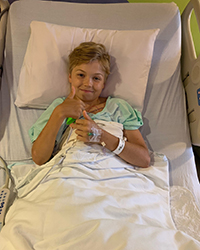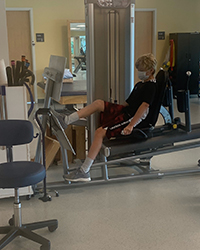-
Services
Featured Specialties
-
Locations
Location Type
-
Patients & Visitors
Published March 07, 2022

In August of 2020, an Eastern Middle School 8th grade student in Greenwich, CT, Brady Lisjak played travel ice hockey for the Connecticut Junior Rangers alongside his teammates just three months after he underwent an operation to increase the length of his right leg by 2.5 inches. The operation entailed cutting the femur bone and inserting a device that slowly moves the two ends of the bone apart. New bone grew to fill in the gap. Recovery involved fierce commitment to physical therapy. Today, Brady, who used to walk with a limp, says the only part that made him flinch was the pre-surgery COVID test.
When Brady was 11-years-old his pediatrician noticed a discrepancy in his hips. She checked for scoliosis and recommended that Brady see an orthopedist. Brady’s diagnosis came after a series of X-rays and tests,” said Kristin Lisjak, Brady’s mother. “Dr. Frumberg called us right after the results were in and that was the first time we heard the term Ollier disease.”
Ollier disease is a rare disorder where non-cancerous tumors form on the bone and can impact growth. Many people with this condition choose surgery as their solution. Dr. Frumberg explained that the only option Brady had aside from surgery was a specially-made shoe lift which can even out the legs while the person wears them, which is impractical for someone young and athletic.
“When there is a leg length discrepancy, surgery is the only option that reduces the risk of arthritis, hip pain and long-term spinal issues,” said David Frumberg, MD, Yale Medicine pediatric orthopedist at Yale New Haven Children’s Hospital, and one of the few physicians who provides lifelong care for people with orthopedic conditions. “However it is a big undertaking for a child to rehab in a way that is consistent and allows them to reap the benefits of the operation.”
The decision to have surgery came after a series of conversations and video conferences with the family via telehealth. “I was nervous at first,” said Brady. “But once I heard more about the operation and learned about another kid in my town who had the same surgery and is doing great – it boosted my confidence.”
Surgery was scheduled for April 2020 so Brady could return to playing hockey in August, however due to COVID restrictions, it was pushed to June 2020 – meaning there was a chance Brady would have to miss the season as a typical recovery is about six months. “With all the pandemic-related changes happening at that time, combined with Brady facing this new challenge of surgery we were rooting for him to be able to return to something he loves,” said Mike Lisjak, Brady’s father.
After the surgery, Brady stayed in the hospital overnight to help with pain management. The following week he was at physical therapy and putting weight on his legs.

“I watched him go from being barely able to move his leg to gaining an inch more of movement each day,” said Kristin, a high school science teacher who had the summer off to be at all of Brady’s appointments. “I have never seen him work so hard and be so goal-oriented. Brady will likely face more surgeries in his future due to the nature of Ollier disease, but seeing his fortitude is a reminder of how resilient he is.” Brady also went to the local pool to develop his strength and was able to attend follow up visits close to home at the Pediatric Specialty Center in Norwalk as well as at Greenwich Hospital’s outpatient physical therapy and telehealth visits. He was able to join the hockey team just three months after surgery.
“Brady healed quicker than I thought he would,” said Dr. Frumberg. “This is in part because he saw the process as a means to an end which can be a struggle for some kids. At our Program, we have the benefit of accessing hospital services, so when we see kids having a hard time with the emotional toll the surgery can take, we offer social workers and other supports to help families get into that goal-oriented mindset, which makes a real difference.”
Dr. Frumberg explained that the surgery, which harnesses biology to grow bones, has evolved over the past 20 years from an extensive procedure where children were sitting in hospital beds for months to an hour-long procedure where patients go home the same day or the next morning. “This was really hard on the kids and even more so on the parents,” said Dr. Frumberg. “Having a family walk away with a good experience is a fairly new phenomenon and it is so rewarding to see such a dramatic difference in such a short period of time.”
Learn more about Yale New Haven Children’s Hospital’s Limb-Lengthening and Reconstruction Program.